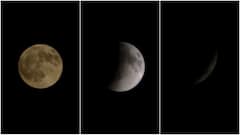Aditya-L1 Solar Wind Experiment Shows Promise, SWIS Successfully Measures Solar Wind Ions: ISRO
According to ISRO, the instrument has successfully measured solar wind ions, primarily protons and alpha particles.

Bengaluru: The Aditya Solar wind Particle Experiment payload onboard India's Aditya-L1 satellite has commenced its operations and is performing normally, ISRO said on Saturday.
ISRO's Polar Satellite Launch Vehicle (PSLV-C57) on September 2 had successfully launched the Aditya-L1 spacecraft, from the second launch pad of Satish Dhawan Space Centre, Sriharikota.
Aditya-L1 is the first Indian space-based observatory to study the Sun from a halo orbit around first Sun-earth Lagrangian point (L1), which is located roughly 1.5 million km from Earth.
In a statement, ISRO said Aditya Solar wind Particle Experiment (ASPEX) comprises two cutting-edge instruments 'the Solar Wind Ion Spectrometer (SWIS) and SupraThermal and Energetic Particle Spectrometer (STEPS). The STEPS instrument was operational on September 10, 2023. The SWIS instrument was activated on November 2, 2023, and has exhibited optimal performance.
"SWIS, utilising two sensor units with a remarkable 360° field of view each, operates in planes perpendicular to one another," the statement read.
According to ISRO, the instrument has successfully measured solar wind ions, primarily protons and alpha particles.
A sample energy histogram acquired from one of the sensors over two days in November 2023 illustrates variations in proton and alpha particle (doubly ionized helium, He2+) counts, the agency said.
"These variations were recorded with nominal integration time, providing a comprehensive snapshot of solar wind behaviour," ISRO said.
The directional capabilities of SWIS enable precise measurements of solar wind protons and alphas, contributing significantly to addressing longstanding questions about solar wind properties, underlying processes, and their impact on Earth, the space agency explained.
"The change in the proton and alpha particle number ratio, as observed by SWIS, holds the potential to provide indirect information about the arrival of Coronal Mass Ejections (CMEs) at the Sun-Earth Lagrange Point L1," ISRO said.
Enhanced alpha-to-proton ratio is often regarded as one of the sensitive markers of the passage of interplanetary coronal mass ejections (ICMEs) at the L1 and hence considered crucial for space weather studies.
(This story is published as part of the auto-generated syndicate wire feed. Apart from the headline, no editing has been done in the copy by ABP Live.)






































